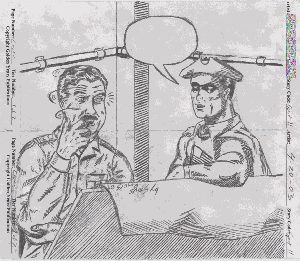
SINCE AUGUST, 1999 |

Library Extra |
 Before
I ever start working on an issue, usually about a month earlier, I have
to decide on that "book's" contents. My formula for doing so is this: Before
I ever start working on an issue, usually about a month earlier, I have
to decide on that "book's" contents. My formula for doing so is this:
Normally at this point I would scan these issues (if I hadn't done so already), but these all came from Bill Nolan's out-of-production Fighting Yank CD. After scanning, comes the cover creation. In the past I used images from the stories with nothing special done to them short of color enhancement, but recently I've been restoring Golden Age artwork, and recoloring it. I do the restoration by separating the CMYK channels of an image, and bringing out the black line art. Usually this will require that I print and redraw by hand as well. In the case of Spotlight #11, I decided to go a different route and create a brand new cover (seen above). Next step: Image Processing. Home
|
|
This site was designed with Microsoft Internet Explorer 6 and Netscape Navigator 4.7 with 800x600 High Color (16 bit) monitor display. If you have another browser and something doesn't look right please notify me of the problem. Thank you.